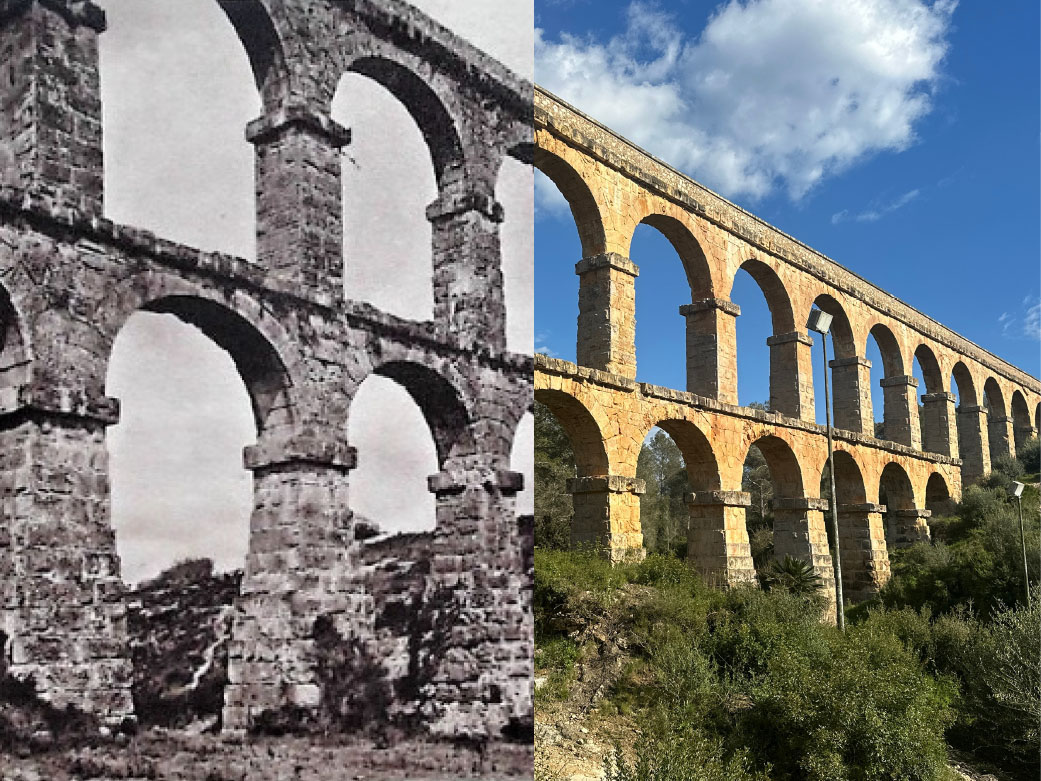Rachel Peets

CAT.
Imatge de postal d'autor desconegut (1928) – Peets (2025)
L'aqüeducte, conegut com a Pont del Diable, rep aquest nom per una llegenda local que diu que va ser construït pel mateix diable. Antigament portava aigua del riu Francolí fins a la ciutat romana de Tàrraco. Amb una longitud de 217 metres i una alçada de 26 metres, aquesta estructura impressionant va ser construïda al segle I dC i és Patrimoni Mundial de la UNESCO des de l'any 2000.
El meu projecte de refotografia representa un pont no només físic o arquitectònic, sinó també simbòlic: un enllaç entre el passat i el present. Durant aquest procés, vaig entendre que la refotografia és més que una simple comparació visual al llarg del temps. Convida a una reflexió més profunda sobre com mirem i percebem un lloc, convertint aquest acte en una forma d'art en si mateix.
La refotografia és, de fet, un camí llarg i amb moltes capes. Requereix coneixement històric i contextual, així com precisió visual. Em pregunto: com serà aquest lloc d'aquí a cent anys? Serà engolit per la natura o transformat una altra vegada per l'activitat humana?
Sigui com sigui, estic agraït d'haver-me aturat un moment per connectar amb el passat a través d'aquest petit però significatiu acte de refotografia.
CAST.
Imagen de postal de autor desconocido (1928) – Peets (2025)
El acueducto, conocido como Pont del Diable -el Puente del Diablo-, debe su nombre a una leyenda local que afirma que fue construido por el mismísimo diablo. Antiguamente transportaba agua desde el río Francolí hasta la ciudad romana de Tarraco. Con una longitud de 217 metros y una altura de 26 metros, esta impresionante estructura fue construida en el siglo I d.C. y ha sido Patrimonio Mundial de la UNESCO desde el año 2000.
Mi proyecto de refotografía representa un puente no solo en sentido literal o arquitectónico, sino también simbólicamente: un nexo entre el pasado y el presente. A través de este proceso comprendí que la refotografía es más que una comparación visual a lo largo del tiempo. Invita a una reflexión más profunda sobre cómo percibimos un lugar, convirtiendo el acto en algo casi artístico.
La refotografía es, en realidad, un camino largo y complejo. Requiere tanto comprensión histórica y contextual como precisión visual. Me pregunto: ¿cómo será este lugar dentro de cien años? ¿Será reclamado por la naturaleza o transformado una vez más por la mano humana?
Sea como sea, me siento agradecido por haberme detenido un momento a encontrarme con el pasado a través de este pequeño pero significativo acto de refotografía.
ENG.
Unknown Author Postcard Image (1928), Peets (2025)
The aqueduct, known as Pont del Diable-the Devil's Bridge-earned its name from a local legend claiming it was built by the devil himself. It once carried water from the Francolí River to the Roman city of Tarraco. Spanning 217 meters in length and reaching 26 meters in height, this remarkable structure was constructed in the 1st century AD and has been recognized as a UNESCO World Heritage Site since 2000.
My rephotographic project represents a bridge not only in a literal, architectural sense but also symbolically-connecting the past and the present. Through this process, I came to understand that rephotography is more than just a visual comparison over time. It invites deeper reflection on how we perceive a place, turning the act into something almost artistic. Rephotography is, in fact, a long and layered journey. It demands historical and contextual understanding as much as it does visual precision. I find myself wondering: what will this place look like in another hundred years? Will it be reclaimed by nature, or reshaped once again by human hands?
Either way, I'm grateful to have paused for a moment to meet the past through this small but meaningful act of rephotography.



 Instagram
Instagram Vimeo
Vimeo Ivoox
Ivoox